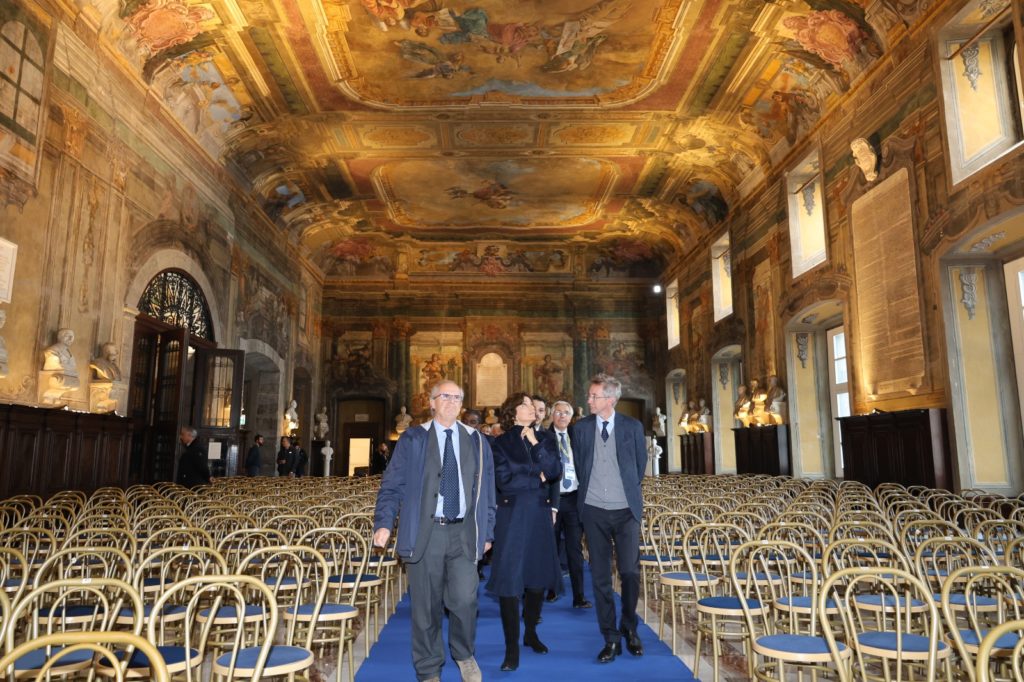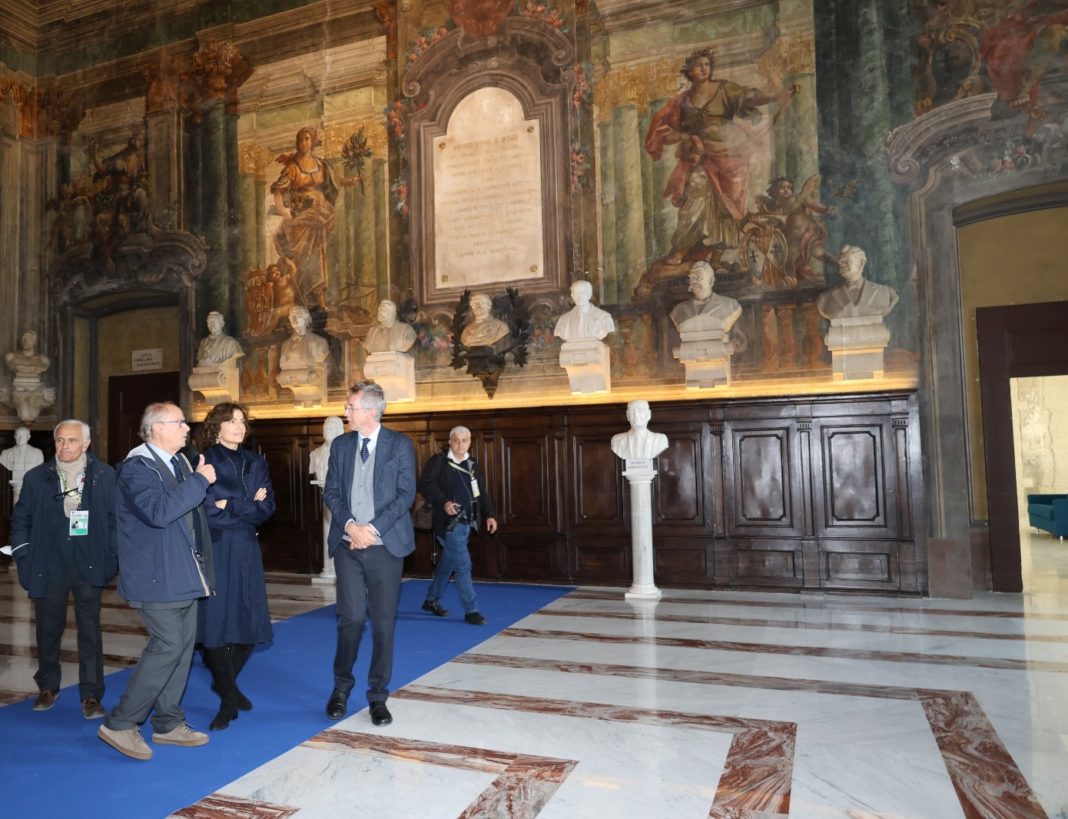Non solo lancio di un documento programmatico, ma anche una rivincita per una città che per molti è ancora la vergogna d’Italia per i fatti di cronaca nera che vi si registrano, un po’ come le sono stati i sassi di Matera negli anni cinquanta per la miseria delle condizioni abitative.
La vergogna d’Italia, con i suoi chiaroscuri, è diventata, però, stella luminosa dell’Organizzazione delle Nazioni Unite per l’educazione, la scienza e la cultura, istituita a Parigi 4 novembre 1946, che nel magnifico Palazzo reale sovrastante l’altrettanto maestosa Piazza del Plebiscito, ha tenuto un summit di tre giorni conclusosi ieri.
Risultato dell’incontro internazionale, la carta finale definita “Lo spirito di Napoli”, ovvero un appello ad agire (“Call for action”) rivolto alle realtà che ne fanno parte per una più efficace tutela della bellezza, mobilitandosi contro i cambiamenti climatici, che hanno effetti disastrosi sulla conservazione dei siti, e contro il turismo di massa che potrebbe snaturare l’essenza dei territori.
Il vicepresidente del Consiglio nonché ministro degli Affari Esteri e della cooperazione Internazionale, Antonio Tajani, ha chiuso ieri la conferenza “Cultural Heritage in the 21st Century”: sua l’idea di proporla nella città di di Partenope che ha stupito le delegazioni di 194 per la sua ricchezza di beni materiali e identitari. «L’Italia – ha detto- è un gigante mondiale della cultura per il patrimonio che conserva, le bellezze che ha, per la storia millenaria, ma anche per tutto quello che sta facendo in giro per il mondo per tutelare il patrimonio artistico».
Con lui la direttrice generale dell’Unesco, Audrey Azoulay che ha ribadito la necessità di «ripensare l’approccio alla protezione di ogni tipo di patrimonio culturale integrando la prospettiva e ponendo la società civile e le popolazioni indigene al centro delle azioni».
Tanto incanto a Napoli, ma anche molto degrado, con numerosi problemi di gestione turistica. Bilancio positivo, tuttavia, per il sindaco Gaetano Manfredi che ha sottolineato come una metropoli così complessa abbia «mostrato tutte le sue anime e sfaccettature, anche quelle meno conosciute. Un’occasione di dibattito, di discussione delle difficoltà nel gestire turisticamente un sito come Napoli. Ma anche sulle opportunità che la città può avere e sulle esperienze che può trasferire a tutto il mondo. Abbiamo avuto grandi apprezzamenti per il lavoro che stiamo facendo. Chiaramente ci sono tante sfide davanti a noi che non sono solo quelle di Napoli. Innanzitutto, c’è l’esigenza di coniugare crescita turistica ed economica con la conservazione e l’equilibrio delle grandi città d’arte, Ma Napoli ha mostrato il meglio di sé».
Sulla tutela efficace nei centri storici delle città Unesco, non solo dei contesti storici e monumentali, ma anche delle comunità locali ha insistito a Italia Nostra.
Nel suo intervento dalla platea della giornata finale della riunione, il Vicepresidente, Luigi De Falco, ha spiegato che servono più strumenti normativi per preservare i centri storici nei processi di rigenerazione urbana, perché il riconoscimento Unesco non è garanzia di vincolo e di tutela.
Per questo Italia Nostra propone di inserire nel Codice dei Beni Culturali e del Paesaggio una norma che ex lege vincoli centri storici e siti Unesco, estendendo in tal senso l’art. 142 (aree tutelate per legge).
E concorda con le dichiarazioni inserite nella carta “Lo spirito di Napoli”, redatta dai delegati Unesco, che sembrano finalmente affrontare il rapporto tra patrimonio materiale e immateriale e individuano nella “gentrificazione” e nel turismo di massa le dinamiche degenerative del contesto sociale dei centri storici che più ne mettono a rischio la tutela.
Italia Nostra auspica che il governo si faccia carico di una norma nazionale che aiuti le amministrazioni locali nei siti Unesco a tutelare i valori architettonici, urbanistici e sociali dei centri storici con maggiore energia, fornendo loro gli strumenti altrimenti mancanti nei piani di gestione.
Il bollino Unesco non può diventare il bacio della morte di un luogo. Occorre applicare finalmente la convenzione di Faro, finora rimasta sulla carta per coinvolgere i residenti nella gestione dei siti e promuovere delle comunità patrimoniali. Affinché i beni culturali non siano sommersi dalle imponenti ondate di visitatori e visitatrici. L’impronta umana sull’arte può distruggerla.

Unesco Conference/Italia Nostra: “Welcome to the Spirit of Naples charta. Let’s protect the inhabitants of the historical centers, the stamp of beauty cannot become a kiss of death”
Not only a programmatic document, but also a revenge for a city that for many is still the shame of Italy because of the crimes that have been taking place for years there, as the Sassi of Matera were the shame of Italy in the 1950s for the misery of the housing conditions.
The shame of Italy, with its chiaroscuros, has, however, become the shining star of the United Nations Educational, Scientific and Cultural Organization, founded in Paris on November 4th, 1946: here was held a three-day summit that ended yesterday, in the magnificent Royal Palace overlooking the equally majestic Piazza del Plebiscito.
Result of this international meeting, the final charter called “The Spirit of Naples”, which is a call to action addressed to its member realities for a more effective protection of beauty, in order to mobilize against climate change, which has disastrous effects on the preservation of sites, and against mass tourism that could distort the essence of territories.
The Vice-President of the Council and Minister for Foreign Affairs and International Cooperation, Antonio Tajani, yesterday closed the conference “Cultural Heritage in the 21st Century”: it was his idea to propose it in the city of Partenope, which astonished the delegations from 194 countries for its wealth of material and identity assets. “Italy,” he said, “is a world cultural giant for the heritage it preserves, for the beauty it possesses, for its millennial history, but also for all that it does throughout the world to protect artistic heritage.
With him was UNESCO Director-General Audrey Azoulay, who reiterated the need to “rethink the approach to the protection of all kinds of cultural heritage by integrating perspective and putting civil society and indigenous peoples at the center of action.”
Lots of enchantment in Naples, but also plenty of degradation, with several problems for tourism management. Positive balance, however, for Mayor Gaetano Manfredi, who stressed that such a complex metropolis has “shown all its souls and facets, even the lesser known ones. An opportunity for debate, for discussion of the difficulties in managing a site like Naples touristically. But also about the opportunities the city can have and the experiences it can transfer to the whole world. We had great appreciation for the work we are doing. Clearly, there are many challenges ahead of us that are not just Naples’. First of all, there is the need to combine tourist and economic growth with the preservation and balance of great cities of art. But Naples has shown the best of itself.”
On effective protection in the historic centers of Unesco cities, not only of historical and monumental contexts, but also of local communities, Italia Nostra insisted.
In his speech from the audience on the final day of the meeting, Vice President, Luigi De Falco, explained that more regulatory tools are needed to preserve historic centers in urban regeneration processes, because Unesco recognition is not a guarantee of constraint and protection.
For this reason, Italia Nostra proposes to include in the Code of Cultural Heritage and Landscape a rule that ex lege binds historic centers and Unesco sites, extending art. 142 (areas protected by law) in this sense.
And it agrees with the statements included in the charter “The Spirit of Naples,” drafted by Unesco delegates, which seem to finally deal with the relationship between tangible and intangible heritage and identify “gentrification” and mass tourism as the degenerative dynamics of the social context of historic centers that most endanger their protection.
Italia Nostra hopes that the government will take charge of a national standard that will help local governments in Unesco sites to protect the architectural, urban and social values of historic centers with greater energy, providing them with the tools otherwise lacking in management plans.
The Unesco label cannot become the kiss of death for a place. The Faro Convention, which has so far remained on paper to involve residents in site management and promote heritage communities, must finally be implemented. So that cultural heritage sites will not be overwhelmed by the massive waves of visitors. The human imprint on art can destroy it.
.










